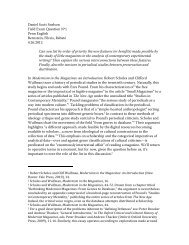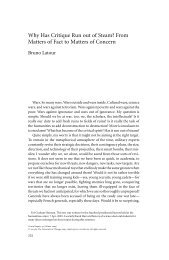The Exploit: A Theory of Networks - asounder
The Exploit: A Theory of Networks - asounder
The Exploit: A Theory of Networks - asounder
You also want an ePaper? Increase the reach of your titles
YUMPU automatically turns print PDFs into web optimized ePapers that Google loves.
50 Nodes<br />
pro cesses include gene expression (how a network <strong>of</strong> genes is switched<br />
on and <strong>of</strong>f to produce proteins), cellular metabolism (how the components<br />
<strong>of</strong> enzymes and organelles transform “food” molecules into<br />
energy), and membrane signaling (the lock - and - key specificity <strong>of</strong><br />
bringing molecules through a cell membrane). Together such pro -<br />
cesses are generally responsible for maintaining the living eukaryotic<br />
cell. And while it would be reductive to say that DNA “causes” each<br />
process, there is an implicit understanding in molecular biology <strong>of</strong><br />
the central role that DNA—as genetic information—plays in each<br />
process.<br />
Base pair complementarity not only implies an informatic approach to<br />
studying life but also implies a notion <strong>of</strong> biological control (gene expression,<br />
cellular metabolism, membrane signaling).<br />
Indeed, this basic principle <strong>of</strong> base pair complementarity not only<br />
lies at the root <strong>of</strong> many “natural” processes in the cell but also drives<br />
many <strong>of</strong> the techniques and technologies that have become associated<br />
with biotechnology. In the early 1970s, when the first genetic<br />
engineering experiments were carried out on bacteria, it was base<br />
pair complementarity that enabled researchers to “cut” and “paste”<br />
segments <strong>of</strong> DNA in a precise manner, paving the way for recombinant<br />
DNA, genetically modified organisms (GMOs), transgenic animals,<br />
and the first biotech company (Genentech). In the early 1980s,<br />
when researchers at the Cetus Corporation developed a technology<br />
for rapidly copying large amounts <strong>of</strong> desired DNA segments (polymerase<br />
chain reaction, or PCR), base pair complementarity again<br />
served as the basic mechanism. And in the mid - 1990s, when the first<br />
oligonucleotide microarrays (or “DNA chips”) were marketed by companies<br />
such as Affymetrix, base pair complementarity formed the<br />
basis <strong>of</strong> the DNA - silicon hybrid chips. All these techniques are currently<br />
part and parcel <strong>of</strong> biotechnology as a set <strong>of</strong> practices, supplemented<br />
recently by the nascent field <strong>of</strong> “bioinformatics.”<br />
As an informatic principle, as a concept concerning “informed matters,”<br />
base pair complementarity can operate across different material substrates,









